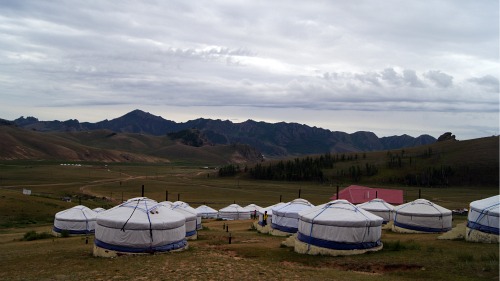reflecting on the traditional life and modern life of Mongolians

Mongolian nomads live on vast plains. But they are destined to move here and there due to the harsh weather in winter. Mongolians, wandering with livestock, have followed the flow of nature rather than conquered the world. That's not all. Some cities like Ulaanbaatar in Mongolia are growing. Jeju-NU news reporters had a four-day trip in Mongolia to study life and culture of Mongolians and Jeju people there. Let's look into Mongolian's past and present life.
Nomad's traditional house 'ger' and rich Mongolian's modern apartment
Nomads still exist in Mongolia. They live in 'ger'(yurt), the traditional house of Mongolia. It is a timber-framed tent that can be easily separated to move in just two hours. Nomads are still moving their dwellings from two to four times a year.
Some people are still living in 'ger' even though they settle in the outskirt of a city. Jeju-NU reporters visited one of the 'ger' dwellers living in the Terelji national park. They had beds, TV, audio, and various home appliances. The host Narangerele (50) served Mogolian traditional tea, named 'Hareuchai', and cookies, named 'Beoreuchuk'. Narangerele said, "I milk my cows and pick some wild fruits early in the morning to sell them in a market."
Modern apartments were also commonly seen in the center of the city. Apartments were usually for rich people, and 'gers' were usually for the ordinary people.
Mongolians still live on meats and dairy products
Korean foods appear on their tables
Nomads' staple foods are meats and dairy goods. Especially, they have various foods that can be carried for a long period of time. 'Irak', fermented horse milk, and beef jerky are preferred in nomadic life.
Settlers also live on meats and milk products. We can easily see their food life in supermarkets. The dairy section covers the whole space of one wall.
These days, Korean foods appearing in Mongolian meals. Because the Mongolian food industry is not that developed, they tend to import foods from other countries. We can see different kinds of foreign foods in many supermarkets, including Korean kimchi, ramyeon, and chamchi . Bodrakmaha(34) said, "We can see lots of food from foreign countries, and I like to eat Korean foods. They are so delicious."
Prices in Mongolia are 1.4 times higher than those in Korea
The average monthly salary of Mongolians is 300,000~500,000 won
Capitalism began to take root in Mongolia after the pro-democracy movement in the 1990s. As billions of dollars in foreign capital flowed into Mongolia to invest in the abundant resources of the country, Mongolia has gone through rapid urbanization. Many youths are flocking to cities to get their careers, but they get in trouble because of their low income and high prices.
Park Hong-Seok, working at a travel agency in Mongolia said, "Most products are quite expensive because they're imported from other countries. Except for some dairy goods. The prices in Mongolia are 1.4 times higher than Korean prices."
Mongolian's monthly wage, however, is not enough for their living. Bodrakmaha said, "Our average salary is 300,000~500,000 won per month. Many people want to work in Korea for a higher salary."
When we looked down on the country from an observatory, we could see grand mountains on one side. Also, we could see tall buildings and large smoking factories on the other side.
As urbanization continues in Mongolia, traditional cultures and new cultures are mingling. Some people are concerned that their traditional nomadic culture might disappear.
Nomads in Mongolia have lived with a love of nature. They couldn't live without grasslands. They had already known this fact a long time ago, and they humbly followed the law of nature. Mongolia, which is pushing itself harder and harder for industrialization, should not forget this precious mind.

